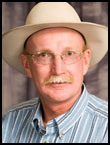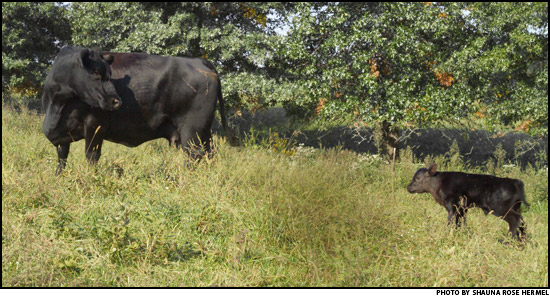
Ron Torell
Back to Basics
Calving barn sanitation
Imagine becoming ill — nothing serious or life-threatening, just something that requires overnight hospitalization. Hospital staff did not have time to clean and sanitize your assigned room, bed or surrounding environment, so they offer you an "as is" discount. Sheets on the bed appear clean from the last patient, who, by the way, died from a contagious disease. Visually, the room appears sanitized and clean. Being the uninsured redneck that you are, you take the deal.
Do you become ill and die? You certainly increased the challenge level. How high is your resistance level? In other words, do you feel lucky?
As ridiculous as the above scenario may sound, many cattlemen play this out every time they run a cow and newborn calf through the calving barn. The uninsured cow, who has no say in the matter, must accept the "as is" accommodations. She may not be at risk; however, the newborn calf with an immature and compromised immune system certainly is.
The calving barn may appear sanitized and clean, but it is often a bacteria or virus cesspool, similar to the "as is" room you were offered at the hospital. Not just cleaning, but thoroughly sanitizing the environment prior to the next patient is paramount and the very basics of animal health.
Calves born to first-calf heifers and those calves born assisted and in a barn setting are at a disease transmission disadvantage compared to calves born in the brush to mature cows. Brush calving provides some protection from the elements, while sunlight, clean soil and fresh open air are sanitary by nature. These are all positive natural disease preventative conditions for successful calving. Calving areas such as feed grounds or calving barns offer the opposite relative to animal health and survivability.
Any time a calf goes through the barn, special attention needs to be made relative to sanitation and trying to keep the area dry. Clorox bleach and water will work well on the smooth surfaces of the pen, such as boards or metal panels.
It will not get the bugs in the soil. The standard recommendation here is to remove all wet and soiled straw or sawdust and get and keep the area as dry as possible. Work lime or lye into the soil. These agents will kill the bugs in the soil (hopefully) and aid in drying the soil. Sunshine, if available, is a great disinfectant. After the above procedures have been completed, lay down clean, dry sawdust or straw as bedding.
Make sanitation Job 1
It seems time is always at a premium during calving. The first corner that is often cut is sanitation. Turn this around and make sanitation the No. 1 priority. Sanitizing calving equipment such as chains, pullers and calving bottle nipples or esophageal tubes before the need for each use will reduce the challenge. Washing hands, boots and changing clothing often, including gloves, are all good management tips.
"Adhere to strict biosecurity measures," warns David Thain, University of Nevada Cooperative Extension veterinarian. "Avoid introducing the sale barn calf to your calving barn. Insist visitors from neighboring ranches thoroughly clean and disinfect boots and outerwear before entering your calving barn area.
"Work with healthy calves first, then work with the high-risk calves," he continues. "This practice will reduce exposure to all calves. Some even place cow-calf pairs that went through the calving barn in a separate field to reduce the exposure level of low-risk calves to high-risk calves. Educate your employees on the subject, and make sure they understand that sanitation is a No. 1 priority. Make sure all who work in the calving barn understand and follow your management practices for sanitation and biosecurity."
Thain goes on to state, "Dipping the wet navel (immediately after birth) of high-risk calves in tinctured iodine helps. The navel is often a major port of entry for disease transmission. Prevaccination of heifers with scour vaccine is a good idea. Precalving feeding of minerals and vitamins to pregnant heifers helps boost the immune system of both the cow and newborn calf. Keeping heifers in a body condition score 6 at calving and a rich diet pre- and postpartum helps increase colostrum quality and quantity, thus newborn thriftiness and survivability. Being observant and isolating sick calves is a necessary management practice."
"Let's not put all our faith into sanitation," warns veterinarian J.J. Goicoechea, Eureka Veterinary Clinic. "Once you get sick, scouring calves in a place, they will saturate the area with infective organisms. We have all heard about the outbreaks of disease in human or animal/veterinary schools or hospitals. Even with their level of sanitation and lots of labor to clean, they have a very difficult time controlling the outbreak. Almost always they end up stopping all new admissions to at least an area or even the entire hospital, until they can get it cleaned up. Do not expect to squirt a little 'stuff' around and have it all go away."
Goicoechea goes on to state, "If at all possible avoid exposing newborn calves to unnecessary pathogens that often are present in a calving barn. This may mean deferring calving dates to a time of year when more favorable weather occurs, calving in the clean brush and/or implementing a system known as the Sandhills Calving System. This system reduces exposure by routinely moving cows that have not calved to new calving pastures, away from newborn pairs. Therefore, all calves within a pasture are of similar age. A case study of a Nebraska 800- to 900-head cattle herd found this system saved thousands of dollars. Bottom line: Follow common sense and reduce exposure whenever possible."

As always, if you would like to discuss this article or simply would like to talk cows, do not hesitate to contact me at 775-738-1721.
Comment on this article.
[Click here to go to the top of the page.]




